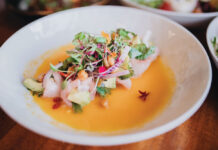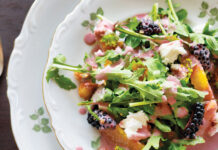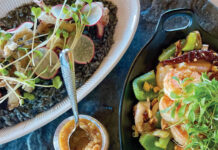Story by Becky Speere | Photography by Mieko Horikoshi & Tori Speere
 It’s early morning, and I’m trailing Sunny Savage into the Ha‘ikū countryside. Savage is the author of Wild Food Plants of Hawai‘i. As I follow her, immersing myself in the moment, I liken our foraging to childhood excursions with my mother, who shared her Hawai‘i-Japanese knowledge of edible plants like pohole fern, bamboo shoots, watercress and wild fruits. Sunny is a bubbling spring, calling out the botanical names of wild plants and their health benefits. I understand some of what she says, but mostly I feign understanding . . . a lot.
It’s early morning, and I’m trailing Sunny Savage into the Ha‘ikū countryside. Savage is the author of Wild Food Plants of Hawai‘i. As I follow her, immersing myself in the moment, I liken our foraging to childhood excursions with my mother, who shared her Hawai‘i-Japanese knowledge of edible plants like pohole fern, bamboo shoots, watercress and wild fruits. Sunny is a bubbling spring, calling out the botanical names of wild plants and their health benefits. I understand some of what she says, but mostly I feign understanding . . . a lot.
We’re harvesting food for a Modern Savage pop-up dinner that will be prepared by some of Maui’s top chefs, for whom Sunny has become a mentor. She has been gathering and processing wild foods for the dinner for months, and invited me to assist her for a few harvests. Her knowledge of wild, edible plants, and their oftentimes off-the-beaten-path locations, turns our foraging into an adventure. Here are my notes from three days at the master’s side.
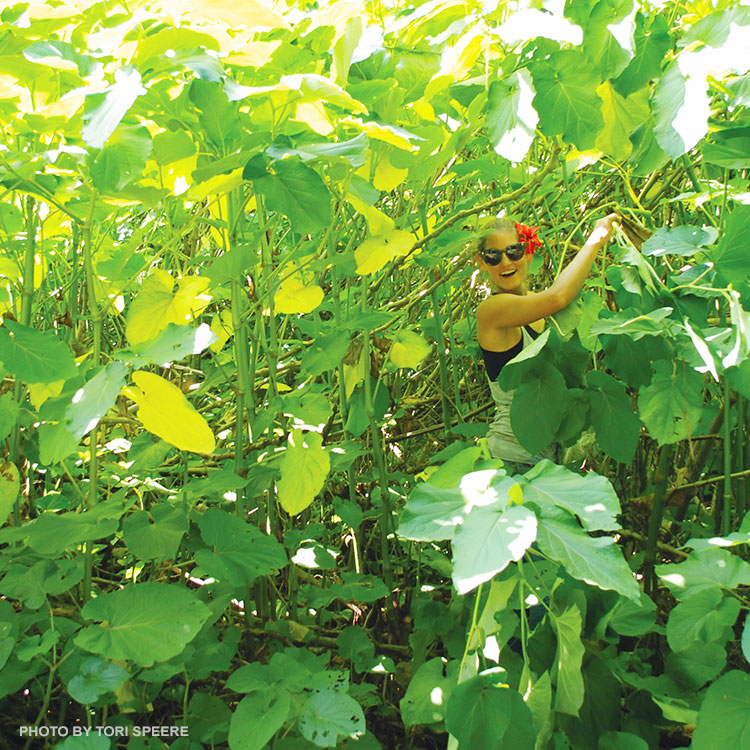
January 25, Evonuk Farms Spent four hours in the organically managed fields, harvesting one scant gallon of wild mallow seeds growing between rows of coriander. The striated, lime-green, seeds conjure images of baby sea urchins, but taste of sweet butter lettuce with a gelatinous mouth feel. Sunny will cook and purée the seeds to create a vegan egg-white substitute. She says, “It’s great for people who are challenged with gastroesophageal reflux disease. It coats the entire intestinal track and soothes it.” So many foods foraged from nature have dual purposes, as nourishment and healing.
February 5, someplace in Huelo Piper auritum (false ‘awa) is an invasive species despised by local gardeners, but it has found a place in our basket today. The white inflorescence doesn’t look like a flower, but like long, skinny tubes dancing at the tops of leggy, ten-foot-tall bushes covered with heart-shaped leaves. Sunny is distilling a potion and must process the plant quickly to capture its delicate, licorice-like aromas. Cooked and puréed, the young, shiny leaves will deliver a big phytochemical punch.
We’re also gathering Polygala paniculata—snakeroot, also known to locals as root beer plant because of its wintergreen-sarsaparilla scent—which Sunny will distill into a hydrosol.
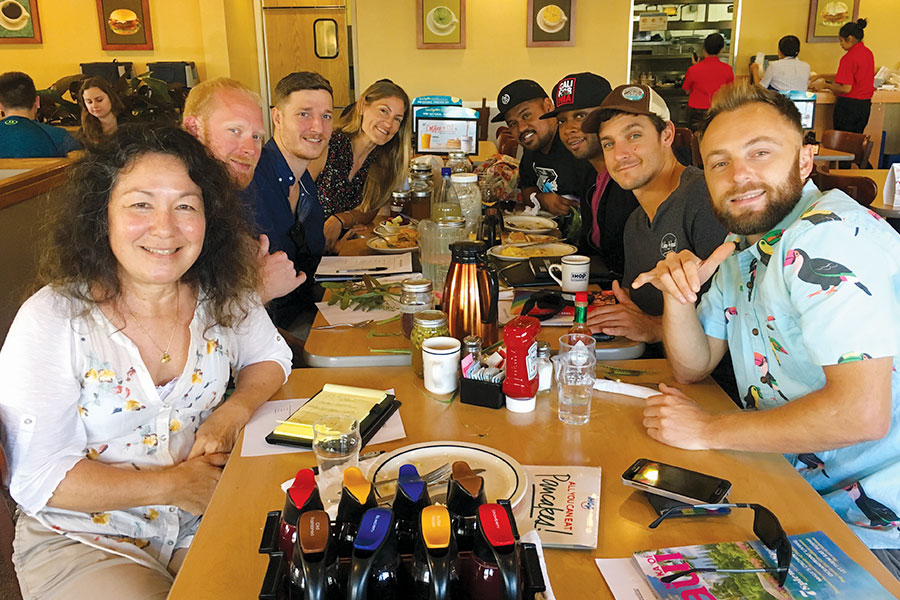
February 15, International House of Pancakes Sunny and I have come to IHOP for a meeting with the chefs who’ll prepare the February 21 Modern Savage dinner. Two of them are former ‘Aipono Chefs of the Year: Sheldon Simeon, of MiGRANT and Top Chef fame; and Jeff Scheer, who runs The Mill House restaurant at Maui Tropical Plantation. Organizing the event are 2013 MNKO “Holiday Test Kitchen” chef Anton Haines of Honu, and Rob Ramshur. Formerly a private chef here, Ramshur now lives in San Francisco, where he works as a chef consultant. He’s flown to Maui for the event, and when I ask him why he felt drawn to planning and executing a wild foods feast, he replies, “To inspire chefs with new ingredients, [and] help spread Sunny’s message of the importance of diversity in our diet. I worked with her last year and it was an experience I wanted to share.” We’re also joined by Leaf & Limb Kombucha, a company that works with organic, fair-trade tea and organic produce from Maui farmers.
Sunny has spent 100 hours foraging wild stuff, and it looks like a Chinese apothecary shop as she places her cache on the table in the middle of the restaurant. Like a rabbit-in-the-hat magician, she dips her hand into the ice chest and pulls out Mason jars filled with dehydrated powdered greens made from mallow leaf, wild Turk’s cap, red hibiscus granules, baby pipinola (chayote squash) pickled in feral fennel seeds, pink peppercorns, Job’s tears leaves, distillates of false ‘awa flowers, elderberry, sandalwood, and butterfly ginger hydrosol; honohono (grass), oxalis, and Erechtites valerianifolia, also known as shin san cho or fireweed.
Sunny has challenged each of the chefs to compose three courses for the dinner. As they examine the wild and unfamiliar plants, you can almost hear their imaginative minds formulating recipes. Sheldon has been assigned dishes that “include eggs” and “something crispy.” He pops a few haole koa seeds into his mouth and declares, “I can use these in my egg dish.” Rob reaches for the pickled baby chayotes and wild mallow. Jeff wants to incorporate shin san cho, kiawe flour and false ‘awa purée in his dishes; while Anton envisions mac-nut mallow foam and nasturtium capers in his culinary creation. Soon each chef has claimed his ingredients and gone his separate way, eager to invent something delicious and new.
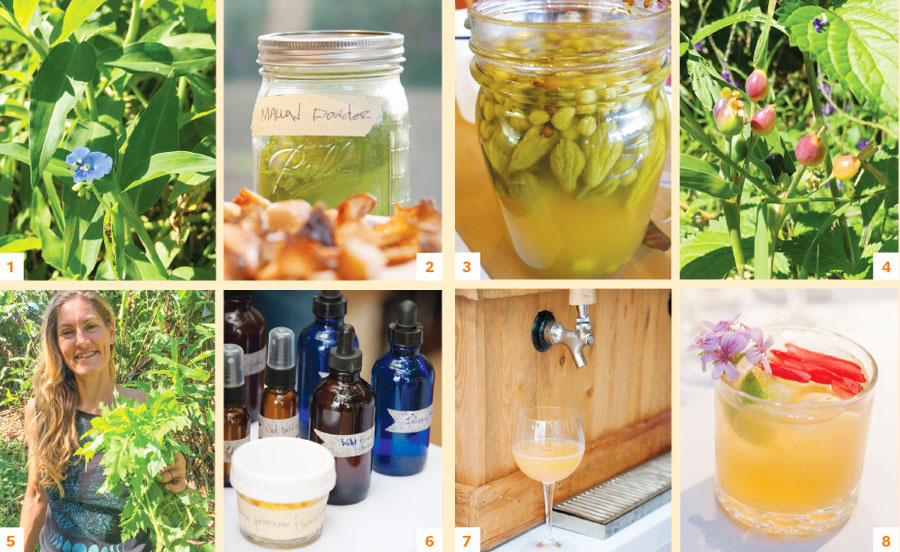
February 19, Huelo It’s early morning again, and dew hangs from the grass blades. One of Sunny’s mantras, she says, is, “Eat at least one wild food every day.” Another: “Eat a rainbow of wild foods [for] the biodiversity of their nutrients.” Wild foods contain more concentrated micronutrients than commercial crops.
We harvest juicy honohono grass tips, false ‘awa flowers, seeds and the leaves of sour oxalis and wild elderberry. Then we drive to a secret spot along the road to Hāna for shin san cho. Originally from Asia, this “weed” hopscotched its way to Hawai‘i via immigrant plantation workers. Sunny peels the hard covering on the stem and we eat the crunchy yet tender centers, which taste sweet and celery-like, and have an intense vegetal aroma.
February 21, Pop-up night at a private home The twelve-course feast is about to begin. Dustin Hampton and Ben Zerbe, owners of Leaf & Limb, serves kombucha “Champagne” cocktails, one with wild elderberry, the other with fruit of invasive banana poka, a distant relative of passionfruit. Petals of rose geranium and butterfly ginger decorate sugar-rimmed martini glasses filled with Hali‘imaile Distilling’s icy Pau Maui Vodka. Hydrosols of wintergreen snakeroot and ginger flowers are placed for guests to spray in their drinks or on their faces for a “wild aromatherapy.”
The dinner begins with Chef Rob’s appetizer: Thumbelina carrots “planted” in a black-plastic seedling tray. The whimsical presentation draws laughter from the guests. We dig our fingers into the individual compartments of onion “soil” that mimics rich, dark compost. Carrots emerge, coated in a sticky, mallow-infused compound butter, and we bite into the tender root, our taste buds tickled with the sweet, herbaceous carrot and oniony “dirt.”
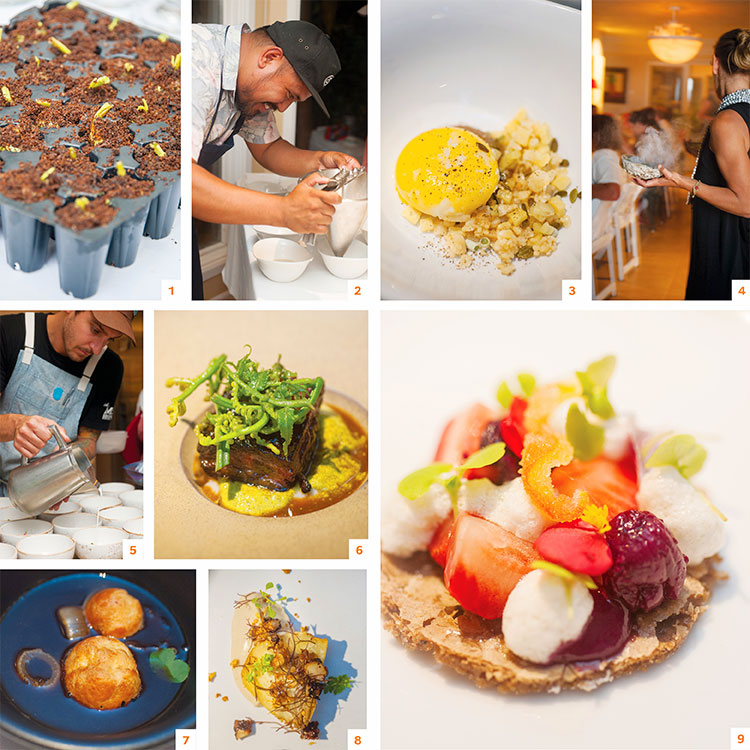
Each course that follow is incredible. A few of my favorites:
Chef Sheldon’s poached egg yolks (from local, free-range chickens) float in a dashi of white miso and brown butter garnished with false ‘awa flowers, toasted haole koa seeds and macadamia granola. Altogether chewy, crunchy and creamy with the slightest hint of licorice, the dish elicits murmurs of delight.
Chef Rob presents an onion soup made with fermented buttermilk, and tells us he “caramelized the onions, dehydrated them to make a powder, and incorporated this into the broth for an intensely oniony flavor.” It’s served with kiawe-flour gougéres filled with buttermilk-onion crème fraiche. The savory pastry is so tender and utterly divine, I could eat an entire plate of it. Sunny adds, “The kiawe pod is dried and ground into a flour that is high in protein and carbohydrates, which makes it a phenomenal food source and a nutritional gem.”
Chef Sheldon reappears, surprising us with a dish that features ‘ulu (breadfruit). “It’s not on the menu,” he grins. “We kinda sneaked it in.” Describing the two preparations: “The first is supa-ripe ‘ulu pudding, and the second is twice-cooked ‘ulu that we boiled in water with chili pepper and garlic, then fried in butter till crispy. We topped it with a kiawe- and guava-wood-smoked tako [octopus] speared at Baldwin Beach. We hibachi-grilled it and finished the tako with Maui Olive Company’s first press. On top, there’s ‘inamona [a relish made with kukui nut], ogo [seaweed] and artillery plant.” Sunny adds, “Artillery plant is in the nettle family, along with olonā and māmaki. You’ll a detect wintergreen flavor from the plant.”
Chef Jeff emerges from the kitchen to tease our senses with an umami powerhouse of tender beef short ribs braised for twelve hours. He serves the collagen-rich cut of beef with nutty burdock-root and a purée of ‘ulu and false ‘awa with nasturtium-caper pesto and fresh pohole.
Chef Anton has prepared two desserts, one a thin, buttery speculoos cookie spiced with cardamom and wild fennel, and crowned with feral berries, and mac-nut foam made with local honey and wild mallow seed. The second: ginger sponge cake infused with butterfly ginger, rose geranium and sandalwood, finished with chocolate cremeaux and a drizzle of hibiscus gel.
As we dip in for our final bites, Sunny says, “It has been beyond my dreams to work with these top chefs. And one thing I’d like you to do is remember the names of these wild foods. Keep using this knowledge. Keep sharing it.”
Doing so will help ensure that these wild and wonderful foods will be there to nourish us tomorrow.
——
Purchase Sunny Savage’s Wild Food Plants of Hawai‘i at SunnySavage.com, Amazon.com, or eBook on iTunes.


